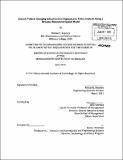Electric vehicle charging infrastructure deployment : policy analysis using a dynamic behavioral spatial model
Author(s)
Kearney, Michael J. (Michael Joseph)
DownloadFull printable version (13.36Mb)
Other Contributors
Massachusetts Institute of Technology. Technology and Policy Program.
Advisor
John Sterman.
Terms of use
Metadata
Show full item recordAbstract
The United States government is committed to promoting a market for electric vehicles. To ensure that this electrification program does not result in the same failure that has come be associated with its predecessor programs, Freedom Car and the Partnership for a New Generation of Vehicles, charging infrastructure must be available. At this point, however, it is unclear what the balance will be between industry and government involvement in enabling the distribution of electric vehicle service equipment (EVSE). A number of companies in the private sector have begun initial deployment projects, and municipalities, utilities and other commercial players are beginning to look into the provision of this equipment. However, little is understood about this market where uncertainties about vehicle sales, costs and government support abound. This thesis analyzes the economics of the infrastructure market and explores the internal logic for the companies involved through a dynamic behavioral spatial model to draw policy recommendations for the roles of the government and the private sector in vehicle electrification. Because of the low cost of electricity and high costs of charging infrastructure capital, it will be difficult for EVSE providers to earn a profit selling electricity. Model simulations demonstrate the importance of a public sector infrastructure roll out strategy and investment innovation in the EVSE market toward faster and cheaper charging options. Policies to stimulate electric vehicle adoption must focus on R&D for charging stations and deploying infrastructure.
Description
Thesis (S.M. in Technology and Policy)--Massachusetts Institute of Technology, Engineering Systems Division, Technology and Policy Program, 2011. Cataloged from PDF version of thesis. Includes bibliographical references (p. 64-67).
Date issued
2011Department
Massachusetts Institute of Technology. Engineering Systems DivisionPublisher
Massachusetts Institute of Technology
Keywords
Engineering Systems Division., Technology and Policy Program.